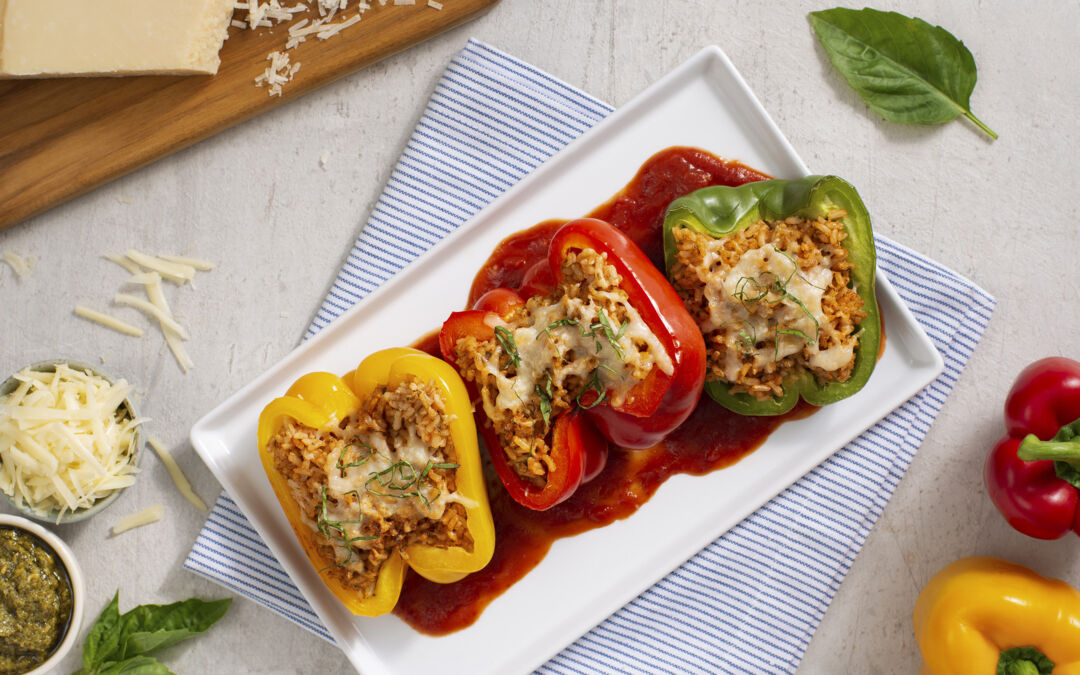Stuffed peppers are without a doubt a convenient family favorite recipe that every true homecook should learn to make. However, there’s more than meets the eye when it comes to putting them together and there is plenty of room for creativity. In fact, there are tons of delicious variations filled with flavors and ingredients from all over the world to use as inspiration!
Many might believe that the secret to nailing stuffed peppers is solely in the stuffing, but the truth is that every bit of the process counts! From choosing the pepper, to using quality grains for the filling or baking at just the right temperature, keep reading to discover how to take your stuffed peppers from average to extraordinary with the help of Success® Rice and Quinoa.
How to Make The Best Stuffed Peppers
There are certain chef-approved tricks that will make your peppers better. From cooking to plating, find the answers to some of the most common questions when making stuffed peppers for outstanding results!
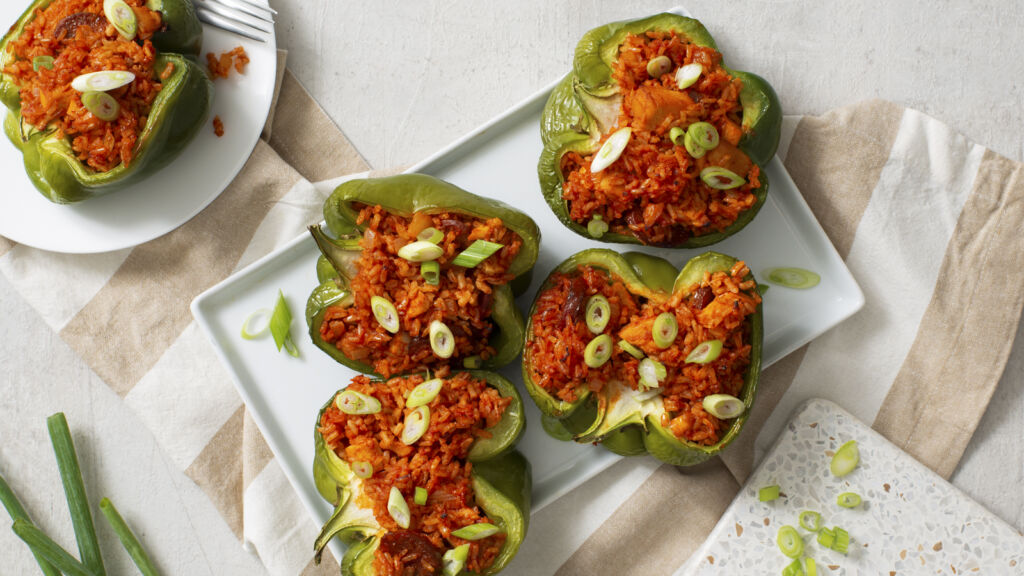
How to Seed and Slice a Bell Pepper
There are two main ways to slice a pepper for stuffing – if you usually use one method over the other, try the other to switch things up!
- The most traditional way is to slice off the cap, remove the stem and seeds, and fill the whole bell pepper. Save the cap for presentation later on or chop up remaining pepper to use in the stuffing or for a flavorful mirepoix.
- The other way is to cut the pepper directly into two halves, leaving the stem on. Use a paring knife to remove seeds and pith.
Fun fact: Did you know you can germinate the seeds at home and grow a bell pepper plant?
How to Prevent Watery Peppers
Ever found your bell peppers sinking into cooking liquids? You are not alone! Watery stuffed peppers is one of the most common problems for a lot of people. To prevent it from happening, you should try to avoid or reduce excess moisture – here are three of the things you can do:
1. Pre-cook Peppers
When you bake peppers that are not pre-blanched or cooked, it is normal that they release their natural water – which can be easily avoided by pre-cooking beforehand. Cut your peppers as desired and remove the seeds, then put them in a large pot. Fill with water until vegetables are fully covered and bring to a gentle boil. Cook for about 3 minutes, spoon out and pat dry to remove excess water. If you are in a rush, you can try microwaving the peppers for about 5 minutes on a microwave-safe plate.
Pro tip: if you prefer to just bake the peppers, an alternative to help release excess liquid is to pierce the bottom with a sharp knife or a fork.
2. Use Leftover Rice
Does this tip sound familiar to you? Like in the best fried rice recipes, it is recommended to use totally chilled and leftover rice so as not to add extra moisture to the filling.
3. Save Cheese for the Topping
There’s no such a thing as too much cheese on your peppers, right? However, if you want to make perfect stuffed peppers, we recommend you skip the cheese in the stuffing and save it for the topping! Cheese can also release liquid so it is always better to use it sparingly and at the right time. Top your peppers with cheese a few minutes before the cooking time is completed and turn on the broil function for the last 5 min to make some melty goodness.
How to Serve Stuffed Peppers
If you want to preserve that Insta-worthy perfect vessel-like shape to surprise your family and friends, you should know that the way you prepare your peppers before baking also matters! To maintain shape and avoid veggies from falling and spilling, it is recommended not to overstuff the cavity and to put your peppers in a small cup-like holder made from tin-foil.
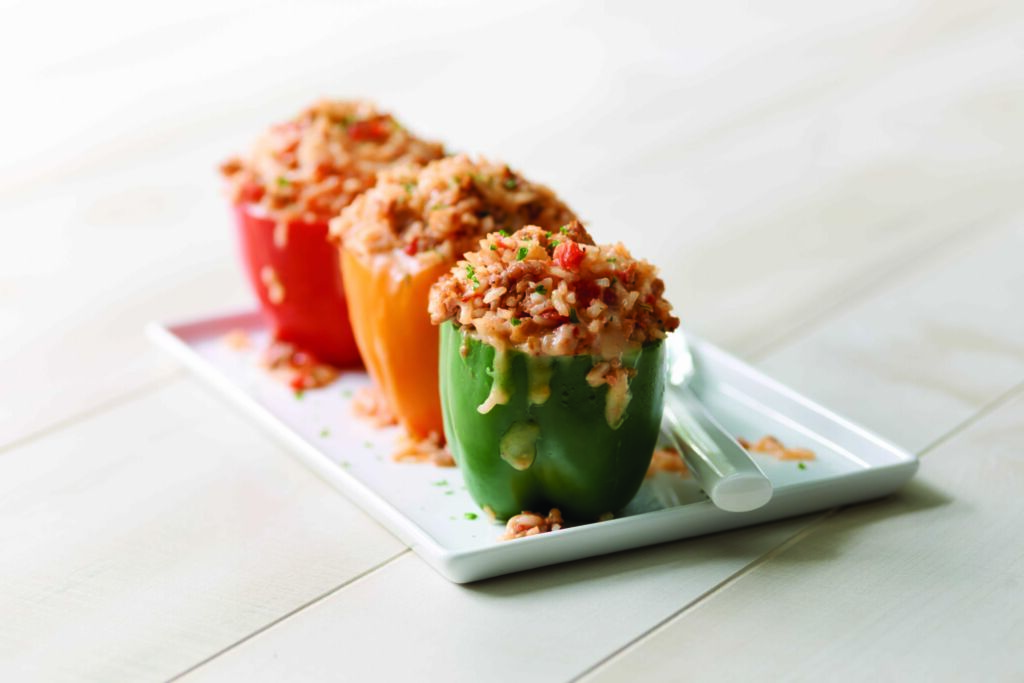
Plating Tips
For an eye-catching presentation, bring the whole baking tray to the table and serve on each plate right before eating. Your guests will surely be delighted by the melty cheese threads when serving the peppers.
Alternatively, serve in the kitchen and top with chopped fresh herbs for a pop of color and an enchanting aroma. You can try it with basil, chives, cilantro or parsley.
Side Dishes
While stuffed peppers can be a meal on their own, if you are hosting dinner you may want to serve something on the side. Our go-to options are either perfectly seasoned quinoa (if your stuffing is with rice), or a light leafy greens salad with spinach, arugula or kale. For the best of both worlds, try our Crunchy Quinoa Spring Salad or this Snap Peas and Quinoa Salad.
Which Peppers Can Be Stuffed?
As you may have seen walking through the vegetable aisle, bell peppers are just one of the many varieties for this fruit cultivar. Fruit? Yes. Commonly recognized as vegetables, most peppers are actually fruits!
Broadly speaking, peppers can be divided into two big categories: sweet peppers and hot peppers. Do you know which are best for stuffing? Let’s find out!
Sweet Peppers vs Hot Peppers
Based on their ranking on the Scoville scale and their flavor profile, we can differentiate between sweeter and spicier peppers. The most pungent and spicy varieties tend to be smaller, which is why sweet peppers, and especially bell peppers, are the best ones for stuffing.
Also known as the Scoville Heat Unit Scale, this system was developed to measure the chili pepper’s taste. The closer to the top, the spicier the pepper is. Varieties like Habanero and Scotch Bonnet have some of the highest spice levels for peppers and the spiciest pepper is Pure Capsaicin, with around 16 million Scoville Heat Units (SHU).
On the sweeter side, bell peppers have 0 SHU units and banana peppers from 0 to 500. If you’re feeling adventurous and want to add a kick to your mealtime, try this recipe for Jalapeño Rice Poppers. Don’t be fooled by the size of these medium-level spicy peppers, they are perfect for a snack or on the side as they will hold a hefty dose of cheese and rice!
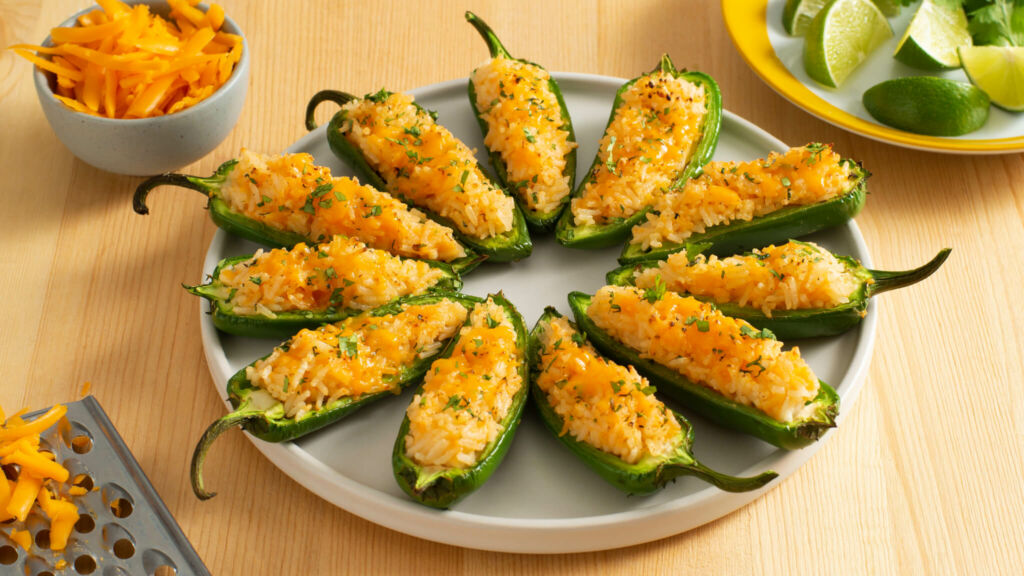
Sweet Bell Peppers
There are also differences within the bell pepper family – mostly in flavor, aroma and color. Would you be able to differentiate these by simply tasting them? Here are some taste cues.
Note: color differences can be tied to ripening stage as well as varietal.
Green Bell Peppers
When bell peppers are green it is because they are completely unripe. Funnily enough, all bell peppers are originally green and develop other colors as the time for harvesting is closer. Because of this, the green ones tend to be more bitter.
This bitter flavor makes them the perfect choice when craving the bold flavors of Tex-Mex cuisine like in this recipe for Santa Fe Style Stuffed Peppers. The addition of ingredients like corn and Colby cheese will balance out the bitterness and add a nice sweet note to the dish.
Yellow, Red and Orange Bell Peppers
In general, all these varieties have a similar taste. They are less bitter and significantly sweeter if compared with green bell peppers. As it happens with other fruits, the flavor changes depending on how ripe the pepper is. Red bell peppers are fully mature.
For a more attractive dish, use different colored bell peppers like in this whole grain recipe for Parmesan Stuffed Peppers with brown rice – or jump on the color block trend by repurposing thanksgiving leftovers in these Feast Stuffed Red Peppers.
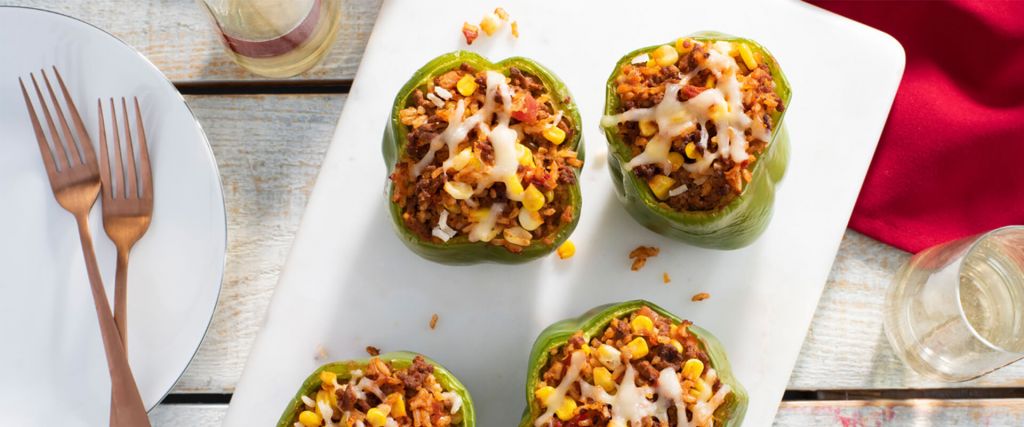
Flavor Tips for Filling
#1 Get inspired by international cuisine
If you’re bored of eating the same classic stuffed peppers over and over again, international cuisine is a great place to start for inspiration to try something new in the kitchen. Take it south of the border by adding Monterey Jack Cheese, black beans and Mexican Rice, or get a taste of New Orleans cuisine by trying your hand at these Jambalaya Stuffed Peppers.
#2 Boost flavors
Stuffed vegetables are versatile. You can add in different ingredients to the stuffing and switch things up every time. However, there’s another alternative if you want to stick to the rice and ground meat for the main ingredients: using sauces and herbs to boost flavors.
Instead of plain tomato sauce, try tomato-based marinara or puttanesca or explore new flavors by adding in pesto – like in this Chicken Pesto Stuffed Peppers with Tri-Color Quinoa. For the herbs, use them either to decorate after baking or add to the flavor base when cooking the meat for the stuffing.
# 3 Try different meats or plant-based alternatives
The reason why many people think stuffed peppers are a great option for reusing leftovers – which they are indeed – is because almost anything can be added into the stuffing!
Whether you want to make a vegetarian meal or a meaty protein-packed dish, you can choose from Italian sausage, ground beef or turkey, shredded chicken, tofu, texturized vegetable protein, mushrooms and more! With the addition of rice and quinoa, your stuffing will be complete no matter if you decide to go completely meatless.
Try this spicy take on Classic Stuffed Bell Peppers and feel free to swap in your preferred meat for the Italian sausage for a personal twist on the recipe.
Looking for some seafood ideas? Try our: fried rice and shrimp.

